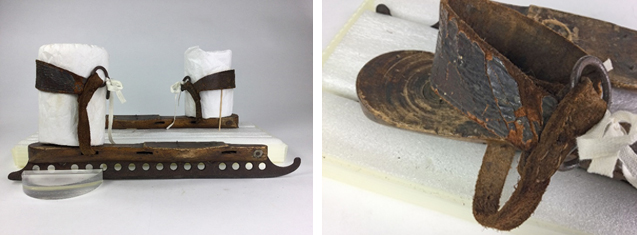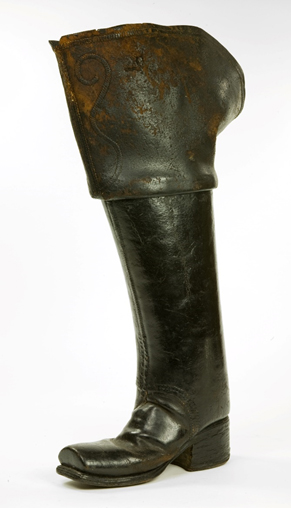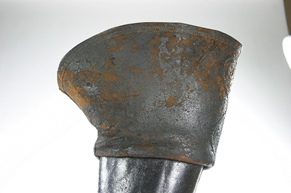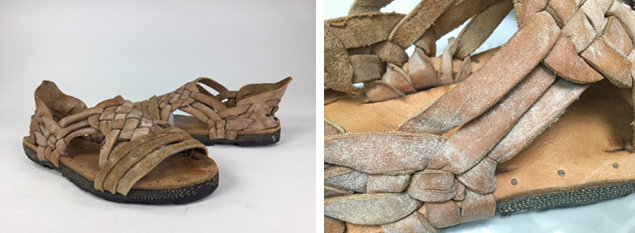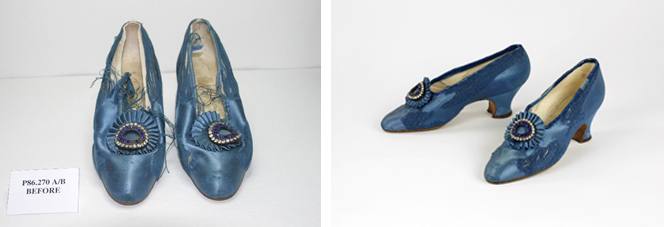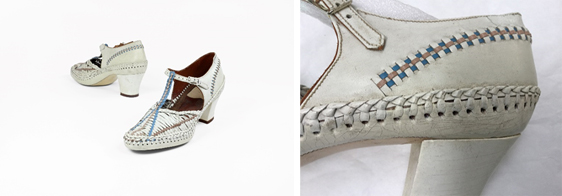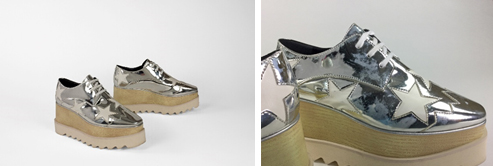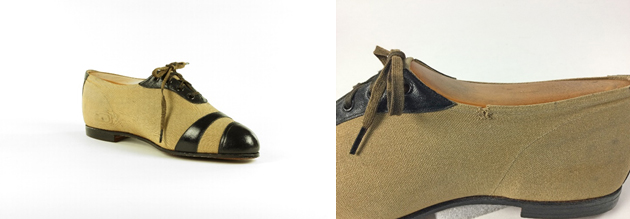People frequently ask for advice on how to care for their vintage shoes at home. As a conservator, I’m reluctant to make recommendations sight unseen. Footwear is made of so many different materials and suggesting a ‘one-size-fits-all’ solution is impossible. Conditions can vary greatly which informs how best to care for them.
Leather can exhibit different types of deterioration depending on age, manufacturing processes, wear and previous storage. Although leather prefers to be slightly acidic, an irreversible condition called red rot occurs when the acidity (pH) of vegetable tanned leather falls to three or lower. The leather turns a telltale rusty red colour, it becomes powdery and tears very easily.
These skates were manufactured by the ACME Company, Nova Scotia, 1895.
Red rot will also cause surface delamination. As the leather starts to powder, it undermines the treatment applied to its surface causing it to spall off, exposing the deteriorating fibres underneath.
The leather on the cuff this ‘Jack’ boot, English 1710 – 1720, was treated with a Japanning technique which creates the shiny black surface.
Commercially available treatments can alter the pH and create stains and darkening of the leather. Sometimes, the leather exhibits a white crystalline deposit on the surface that can be very difficult to remove. This fatty spue can be a result of the tanning process or the application of commercial or homemade dressings. In these sandals, the crystals are trapped between the fibres of the flesh side of the leather and imbedded in the pores on the grain side, making them challenging to extract.
From Mexico, Chiapas, San Cristobel, 1995 – 1997.
In the late 19th century to early 20th century, metallic salts were applied to silk fabric before it reached the retail market. This had a variety of purposes: it increased the drape of the fabric, added to its overall weight allowing the merchants to make more money as silk was sold by the pound and was also used as part of the dyeing process. With time these salts cause the fabric to degrade, destabilizing the weave, creating the shredded look you see in the blue pumps in the photographs below.
Made by Nicklich, Paris, 1910 – 1920. This project was undertaken by a conservation intern in 2007 to support the shredded silk satin.
Leather finishes and modern replacements can be quite deceiving. Faux leather is manufactured with a variety of materials and each presents its own dilemmas for care. The woven bands of the shoes below are leather but the base of the vamp and the bottom of the quarters (around the heel) have been coated with cellulose nitrate. This additional treatment has hardened the leather to which it is attached, becoming brittle and its surface has developed a very fine network of cracks.
Made in the former Czechoslovakia, now the Czech Republic, Bata Zlin, 1925 – 1935.
Contemporary shoe designers that are concerned about animal welfare and advocates for sustainability use synthetic materials in place of leather in their footwear. These platforms, designed by Stella McCartney, were acquired by the museum in 2017, which is close to the date they were manufactured. When they arrived, they were in a gently worn condition. However, in the past 4 years the polyurethane/polyester surface has started to develop a different kind of white crystalline bloom.
With all this in mind, the best advice I can give to collectors of vintage and designer footwear is be kind to them. If you wear them, gently clean the surface with a very soft bristle brush. Be extremely careful to not drag the bristles over the surface as any grit may leave scratches or become imbedded in exposed leather fibres. If you’ve worn them, give them 24 hours to breath, allowing any moisture from your feet to evaporate. Provide internal support to help keep the intended shape. You can use white (uncoloured) tissue paper or even old clean white socks. Don’t over stuff, you’ll know when that happens as they’ll have a puffed-out-cheeks look, and over time will retain that shape. Be careful of using shoe or boot trees as the tension they create can tear fragile seams. Sometimes, leather and textiles will shrink as they age making it impossible to remove these rigid supports, even causing tears in the material at the point of greatest strain.
Bata Zlin 1895: this shoe has shrunk so tightly around the wooden form that it cannot be removed even if the lace is undone.
Storage rooms in museums are all about controlling the environment in which the collections are maintained while not on display. Don’t store shoes in the basement, attic or garage. These areas of your home can experience extremes in temperature and humidity. If you have a group of shoes, keep each pair in their own box on the floor of your clothes closet or on an upper shelf. You can by acid free archival boxes and tissue paper from conservation supply stores.
If you decide to exhibit your collection, place it in a cabinet with glass doors. That way you can see the finds you’ve sleuthed and prevent dust from gathering on their surfaces. You will want to have your display in an area that doesn’t get direct light from windows, isn’t near an exterior door (extremes in temperature) or near a heating/cooling source (such as vents for duct work for your home heating and cooling system or heaters). Also, beware of in-cabinet lighting. Depending of the type of lighting, heat can build up inside and over exposure will cause photochemical deterioration.
While these modest recommendations for care are not dramatic, sometimes passive interventions are the best.
Ada Hopkins
Conservator



